Digital Natives in a Digital Age
As a 22-year-old about to graduate university and enter the workforce, it has become clear to me that there is a disconnect between the ways most businesses view and communicate with my generation, and the best practices for actually engaging with us. I’m tired of getting impersonal and dry communications from businesses. A communication revolution is coming, and businesses that communicate using personalized and relevant messaging are leading the charge. Let’s change the way we communicate.
‘Digital Native’ was first coined by Mark Pensky in the paper, “Digital Natives, Digital Immigrants”, which was ahead of its time when first published in 2001. The term describes the generation that have spent their entire lives surrounded by technology—Generation Z.
We’ve seen such drastic developments in technology in a short amount of time. We’ve gone from flip-phones to smartphones, and digital natives have become accustomed to communicating with the latest, most convenient technology. When it comes to communicating with businesses today, 90% of people say they’d rather receive a text than a phone call.
We are seeing the gap widen between businesses that are investing in developing their understanding of how to effectively communicate with digital natives, and businesses that aren’t adapting. Understanding your consumer’s channel of choice, establishing a branded voice, and testing different communication styles will put you ahead of your competition.

Figure 1: Social Media, Social Life Infographic (Common Sense Media)
Texting is the preferred method of communication for my generation, for both their interactions with friends and businesses. Furthermore, according to a study done in 2017, 61% of people regularly ignore phone calls. If this trend continues (and it's expected to), it is paramount to communicate with customers in their channel of choice. Why should you care about optimizing communications with Millennials and Gen Z’ers? If your target market doesn’t consist primarily of Millennials and Gen Z’ers right now, it will soon.
P.S. For an in-depth look at how Millennials are changing the insurance landscape–with insights from industry leaders–check out our latest whitepaper here.
Digital Age Problems Require Digital Age Solutions
A problem that many businesses face when it comes to effectively communicating with Millennials and my generation is the time investment required to keep up with the evolving technological landscape, consumer preferences and expectations.
In addition, identifying which channels need to be improved, and then choosing the correct solution that best fits the problem is no small task. If you’re wondering if your business could benefit from adding new communication channels to your offerings, first ask these questions:
- Which channels does your target market use the most?
- How are you collecting and managing customer consent?
- If you have a consent management program, is it secure and legally compliant?
- Is your business infrastructure agile enough to add additional communication channels to the mix?
Consumers’ increased expectations when it comes to their experience means that you need to be cognizant of how optimized your customer journey is. Do you know what your customer journey looks like in each stage? Do you have a strategy that allows you to measure where the pain points are, and improve them?

Figure 2: Customer Journey
The benefit of implementing solutions that can help you optimize and streamline the customer journey is that it will increase the lifetime value of your existing customers and allow you to increase revenue without increasing your total number of customers.
So how can businesses keep up with a technological landscape that is constantly changing, and consumer expectations that are continually rising?
Improving the Customer Journey Through Outbound Communication
If you want to build an outbound communication strategy that has any hope of resonating with my generation, it needs to be multichannel at the very least, and preferably omnichannel.
Stay away from robotic-sounding automated calls. Consumers hate getting irrelevant, generic messages. That’s a one-way ticket to losing your customers. The amount of readily- available information on the internet allows customers to instantly compare you to competitors. Coupled with low switching costs, it is now easier than ever (particularly for insurance customers) to change providers. With this in mind, every single customer interaction needs to be relevant—regardless of your industry.
Any outbound communication solution you choose to implement should include the following elements:
- Seamlessness – Integrate with your CRM system to allow you to contact and track communications
- Scalability – Handle and automate any number of outbound communications
- Security – Manage customer data safely and legally
- Personalization – Pull customer data from your CRM and input into data points into messaging
- Automation – Create and run communications campaigns without the need for manual intervention
- Relevance – Deliver human-voiced and timely messages to tap into customers at the most relevant points in their journey
- Measurability – Record campaign and message data to create actionable insights, and accommodate future optimization
Building better customer relationships, improving your customer experience, and optimizing your customer journey all begin with how you choose to interact with your customers.
P.S. Check out our Webinar to learn more about how to optimize your SMS Campaigns, here.
Building Relationships by Giving Your Brand A Voice
Product differentiation and cost leadership are two of the most common ways businesses separate themselves from their competition. However, there are ways to differentiate your business without investing in either of those two strategies. Leveraging your brand personality is one of the most undervalued, yet effective, methods of differentiation. A good example of this is Progressive Insurance’s Flo. Progressive has built Flo to match their intended brand personality and has seen a large increase in their brand recognition in doing so. Other examples of brands leveraging their personality effectively are Wendy’s and Burger King’s Twitter accounts, Bud-Light, and Lego.
Inserting your brand personality into your outbound communications is one of the easiest ways to start building authentic relationships with your customers. Building loyal relationships with customers has the added benefit of increased engagement and personalization when you do reach out with product/service offerings. Proactively starting the conversation with your customers in their channel of choice, adding brand personality, and being consistently responsive in those channels will increase the perceived level of convenience and trust, and differentiate your brand in the marketplace.
Summary
The rapidly changing consumer preferences, technological landscape, and competitive atmosphere have forced businesses to adapt or die. Digital Natives are forcing an evolution towards faster, more convenient, and more intuitive tools.
In order to stay competitive, businesses need an effective outbound communication strategy that works synergistically with their customer journey optimization strategy.
Understand which channels your target market is the most active in, and then disproportionately invest time and resources in communicating and building a relationship with them – and not just as a faceless company. You need to be relatable.
Research and invest in a solution that best suits your goals and will help you execute on your strategy. And make sure this solution is seamless, scalable and secure, with capabilities that include personalization, automation, relevancy, and measurability.
Agree? Disagree? I’d love to hear your feedback! Feel free to drop me a line at carter.clark@splicesoftware.com.
To learn more about how SPLICE Software can help you achieve your outbound communication goals, contact us here.

